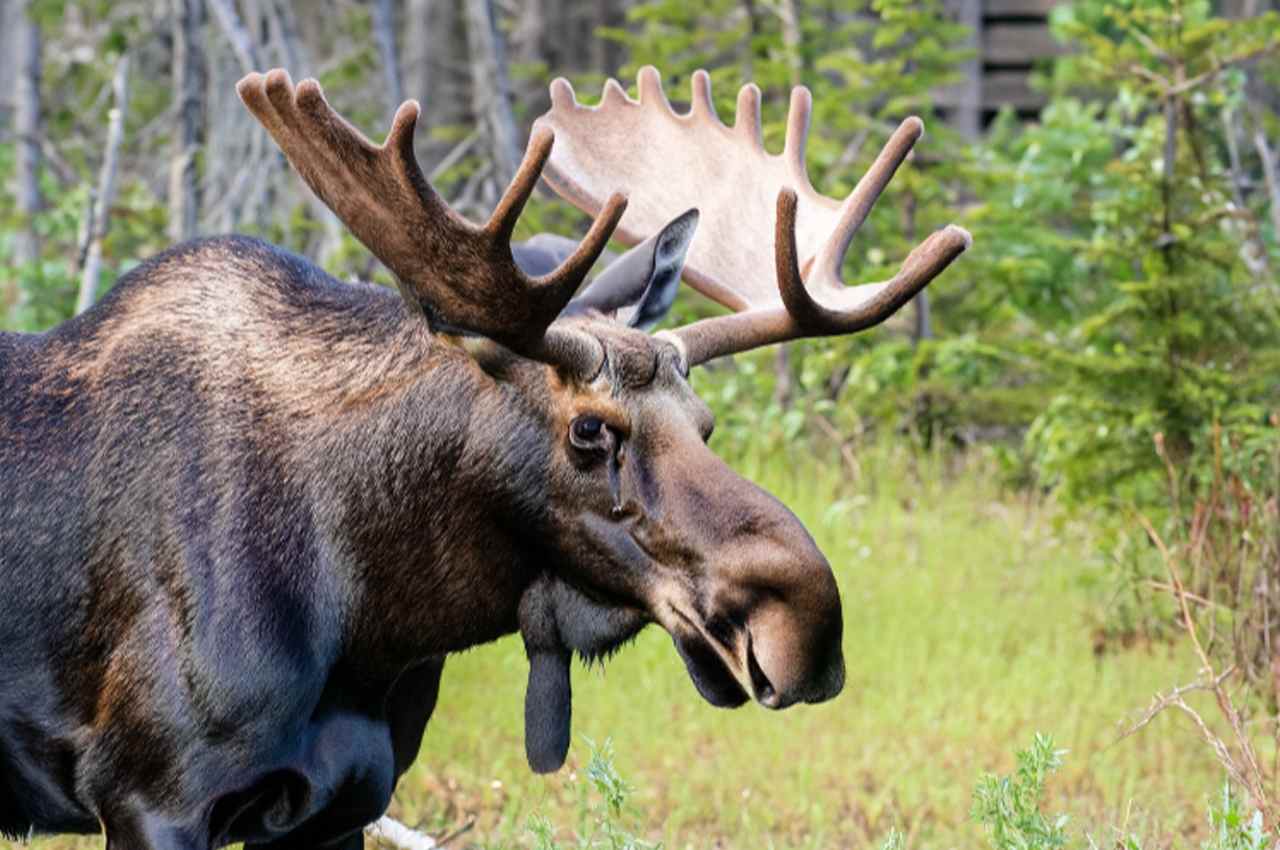What sound does a moose make when it clicks its teeth or rattles its antlers on brush? One of the most well-known creatures in North America, Europe, and Russia is the moose. Known for its height, sweeping antlers, and unique vocalizations, the moose is the largest deer. However, what noises do moose truly make? The vocal range of the moose ranges from low grunts to prolonged wails, and it is just as intriguing as the animal itself.
What Sound Does a Moose Make?
Moose produce a range of sounds, such as grunts, snorts, and bleats. These sounds are often used to communicate with other moose, but they can also be used to express emotions such as fear, anger, or happiness. The sounds made by moose may be fascinating and crucial to their communication. A brief explanation of these sounds is provided as below:
| Sound | Description | Purpose/Emotion |
|---|---|---|
| Bellows | Loud, bellowing sound for communication, especially in mating season | Mating communication |
| Grunts | Low, grunting sound expressing aggression or dominance | Aggression/Dominance |
| Snort | Short, sharp snort indicating surprise or alarm | Surprise/Alarm |
| Moo | Deep, mooing sound used to call for a calf or communicate with other moose | Communication |
| Whinny | High-pitched whinny expressing distress or pain | Distress/Pain |
Moose Vocalizations by Age and Gender
| Call Type | Description | Made By |
|---|---|---|
| Bellow | Loud, wavering siren-like wail | Bull moose |
| Roar | Deep guttural grunt | Bull moose |
| Grunt | Low frequency throat clear | Bull moose |
| Moan | Long, undulating call | Cow moose |
| Mew | High-pitched bleat | Cow moose |
| Bleat | Plaintive cry | Calf moose |
| Bawl | Loud extended bleat | Calf moose |
Real moose Sound from the Wild
Reasons Moose Make Sounds
| Call Type | Purpose |
|---|---|
| Grunts | Attract mates |
| Roars | Establish dominance |
| Bleats | Mother-calf communication |
| Growls | Warn of danger |
Moose are solitary creatures which only congregate during breeding season. As moose have little possibilities for visual or physical encounters, voice communication is essential for them. Moose calls have a number of crucial functions.
- Attracting mates- Male moose bellow and grunt to summon females during the autumn mating season. In addition, females make a lengthy, nasal moan to indicate that they are ready for a mating.
- Establishing dominance- During the rut, men use roars and grunts to ward off competition from other males.
- Mother-calf communication- Mews and bleats are two sounds that cows make to communicate with their calves. Calves that are in distress bleat and wail.
- Warning signals- Males and females both emit a guttural growl as a warning to potential predators or to alert those around to a potential threat.
The social organization and behavior of moose may be better understood by comprehending the context of their vocalizations. Only moose can comprehend the intricate language formed by the many noises.
Male Moose Sounds
During the mating season, known as the rut, male moose, known as bulls, make three different noises to communicate with other moose:
Bellow
The most known moose cry is the bellow. Bulls expand unique air sacs in their throats to make this loud cry. Their nostrils are pushed open, releasing an unsettling, wavering cry that echoes for miles.
Bulls roar loudly as they go around to demonstrate their dominance and entice females. One of the distinguishing noises of the Northern woodland is the eerie roar.
Roar
The roar is a male moose’s powerful, guttural grunt produced in reaction to danger. Moose make a loud, aggressive roar by quickly pushing air from their throat sacs in order to intimidate competitors and claim territory. The roar indicates that the moose is prepared to fight if necessary.
Grunt
Short, low-frequency sounds called grunts resemble a bull cleaning its throat. Bulls grunt to attract females and signal that they are ready to mate when they are near by. Although the grunt is not very loud, it lets nearby males know that the bull is in charge.
Sound of a female moose
Two distinct vocalizations are predominantly made by female moose, known as cows:
Moan
The cow moose groan is a protracted, fluctuating sound used to entice prospective mates. Cows keep their lips open while vibrating specific vocal tissues to produce this sound. The moan’s pitch fluctuates up and down, like a prolonged human groan.
Cows continually groan to attract bulls to their position and communicate that they are ready to procreate. The moose’s sorrowful, unearthly groan may be heard resonating across their isolated surroundings.
Mew
A high-pitched mewing sound is another form of communication used by female moose to reach their young. Mews are gentle bleats, resembling brief coughs, used to keep in touch with calves. The mew comforts and reassures calves, just as a person would a wailing infant.
Calf Moose Sounds
When removed from their mothers, newborn calves shriek in a distinctive high-pitched manner. The cow uses this bleating noise to find her lost youngster.
Calves’ voices become deeper as they get older. However, they continue to communicate with their moms by making empathetic bleats and bawls to express anxiety or hunger. The cow responds with a reassuring mew.
Other Moose Sounds
Moose communicate in addition to vocalizations by:
- Antler rattling- Bulls will ratchet their antlers against vegetation and trees to demonstrate their power during mating season.
- Stomping- Cows stomp their front hooves to warn calves of approaching danger..
- Snorts- Moose snort loudly to express annoyance or dominance.
- Clicks- Moose make clicking noises with their teeth while they are nursing to let the calves know they are happy.
These actions go well with the varied vocal repertoire of moose.
What Moose Vocalizations Are Used For
It’s simple to see why moose vocalizations sound so enigmatic when heard resonating hauntingly over lakes and woodland clearings. However, each sound has a specialized function to convey demands, establish dominance, or warn of danger.
The nuances of moose language and meaning are still being uncovered via research into their grumbles, roars, and eerie wails. The behavior and social organization of moose may be better understood by studying their vocal techniques, which also contributes to continuing conservation efforts for this iconic creature.
So pay great attention the next time you’re outside exploring moose habitat; you just may be fortunate enough to hear the moose’s captivating vocalizations for yourself.
Moose Sounds and Communication
| Moose Vocalization | Description | Purpose |
|---|---|---|
| Bellow | Loud, wavering sound | Attract mates and declare dominance |
| Roar | Low, resonant grunt | Express aggressiveness |
| Grunt | Brief, low-frequency sound | Announce preparation for mating and summon cows |
| Moan | Long, wailing moans | Entice bulls during mating season |
| Mew | High-pitched bleating sound | Calves' communication |
| Bleats | Anguished cries | Indicate need and sorrow (calves) |
| Loud, prolonged bleating | When frightened or looking for the mother (calves) | |
| Additional Communication Noises | Stomping of hooves, Clicks of teeth, Snorts, Antler rattling on brush | Various forms of communication and signaling |
| Reasons for Moose Vocalizations | Attract mates, Establish dominance, Mother-calf communication, Warn of danger, Signal irritation | Various social and behavioral functions |
Characteristics of Moose Calls
Here are some interesting details on moose vocalizations in general:
- Bull bellows may be as loud as a rock concert at 115 dB.
- Cow moose groans may change in pitch by up to three or ten notes.
- Within 15 minutes after birth, calves start to bleat.
- Bulls that are in charge scream around ten times more than less powerful males.
- To communicate across great distances, moose employ infrasonic noises that are below the human hearing range.
- Through unique air sacs in their necks, bulls bellow and grunt.
- With only their voice and hands, hunters can imitate basic moose cries.
- Vocal sacs in moose possibly came from a distant progenitor that also included goats and sheep.
- Researchers are still trying to decode the complex language formed by their variety of vocalizations.
Understanding these beautiful creatures’ noises provide a doorway into the secretive realm of moose behavior and communication.
How far can moose calls go
Moose vocalizations are made to be heard far away. The following variables affect how far moose sounds may travel:
- Volume- Louder cries, like bellows, have a greater range than more subdued grunts.
- Terrain- Sound dissipates more over water and snow than permeable woodlands due to the topography.
- Weather- Clear, calm days allow calls to go further than those with wind or precipitation
- Obstructions- Buildings and natural features may bend and impede sound waves.
Some moose noises have the potential to travel up to:
| Call Type | Approx. Distance Traveled |
|---|---|
| Bull bellow | Up to 5 miles |
| Cow moan | 1-3 miles |
| Calf bleats | 1/2 mile |
Because they inhabit isolated regions, moose have developed vocalizations that can travel great distances. However, precise transmission is influenced by a variety of environmental conditions.
Impersonating Moose Calls
In an effort to attract moose during hunting season, many moose hunters imitate bull grunts and cow groans. The distinctive moose cry may be imitated with only your voice and your hands cupped over your lips with practice. To entice both sexes into range, hunters combine powerful bull grunts with longer, higher-pitched cow moans.
Being patient is essential since approaching moose could be cautious. However, simulating real moose sounds allows hunters to take advantage of the animals’ innate breeding instincts.
To get bulls and cows within range, many moose hunters imitate genuine moose noises. Here are a few advices:
- Before bulls come in the early part of the season, use cow groans and calf bleats.
- As the rut proceeds, include bull grunts to attract powerful males.
- Act like a young bull bugging a cow to attract older bulls
- Cow calls should have a pitch that fluctuates between E and C on the scale.
- Pinch your nose to shriek out the end of calls.
- Cupped hands around the lips may be used to enhance and deepen calls.
- Hiding downwind, make sporadic calls every 20 to 30 minutes.
- If a bull replies and approaches, proceed with great caution.
With practice, hunters can imitate moose vocalizations in a startlingly lifelike manner to communicate with this iconic animal. But you must use care while approaching these large, strong creatures.
Frequently Asked Questions
What does a bull moose sound like when calling?
A bull moose emits a variety of noises. The bellow, a shrill, wavering cry that resembles a siren, is the most recognized. Bulls yell continuously to entice females during mating season. The roar, a powerful guttural grunt used by male moose to assert dominance over other males, is another sound they emit. Bulls may sometimes grunt when attempting to mate with a female.
Why do female moose moan?
During mating season, female moose, often known as cows, emit a prolonged, nasal moaning sound to attract male moose. When a cow is ready to mate, a bull moose will be called to her position by a groan cry that varies in pitch and travels over great distances. Only female moose make this prolonged, wailing sound.
How can you tell a moose calf is in distress?
A moose calf that has been removed from its mother may bleat or bawl loudly and piteously. The cow moose uses her high-pitched sobbing sound to find her lost offspring. From only a few minutes after birth until their first year, when they are still dependent on the mother, calves utter this recognizable agitated bleat.
What does it mean when a moose grunts?
Moose grunts are throaty, low noises. In order to attract female moose for breeding, bull moose grunt closely. The grunt alerts surrounding males to the bull’s supremacy. Cow moose also sometimes soothe or reassure their young by making low grunting noises. A grunt often expresses satisfaction or breeding intentions.
How far away can you hear a moose?
Moose sounds may travel a distance of several kilometers under perfect circumstances. While a cow moose’s groan may only go a few kilometers, a male moose’s bellow may travel up to five miles. The distance is affected by the call volume, the weather, the landscape, and any obstacles. Because they inhabit isolated locations, moose vocalizations are made to be transmitted across great distances.
Conclusion
Overall, what sound does a moose make serves various purposes, including attracting mates, establishing dominance, communicating with their young, warning of danger, and expressing irritation The many vocalizations of moose provide a glimpse into their fascinating world, ranging from the eerie roar of a rutting male moose to the pitiful bleat of a newborn calf. Moose largely depend on their extensive variety of grunts, roars, groans, and squeals to communicate with one another, locate mates, and guard their young. In the far northern woodlands and tundra moose dwell, their distinctive cries have been uniquely developed to travel vast distances. Understanding moose communication provides useful insight into their social behavior and is a source of constant intrigue. The next time you’re outside, stop and pay great attention in moose country because you could just hear these beautiful animals’ profound echoes in the distance.
- California Deer Hunting Guide: Seasons, Rules, Permits, and More - 26 June 2024
- Arkansas Deer Season 2024 [Schedules, Licenses, Bag Limits & More!] - 26 June 2024
- 2024 Arizona Deer Season New Dates & Rules! - 25 June 2024




